Best Free CRMs:
Agile CRM Review
This Free CRM review of Agile CRM was done using CRM Testing Methodology v2.
Agile CRM’s tagline “Sell & Market Like the Fortune 500” seems to indicate that with it, you’ll be able to sell like true corporations. That means taking on Salesforce head-on and presumably for a fraction of the price.
We’ll looking strictly at the FREE version in this Agile CRM review and assess if it solves sales leaders’ problems – for nothing.
You should have a look at the testing methodology to see what the items we’ll test for are and why. Here’s what you’ll find in this free Agile CRM review – and to some extent their paid versions as well:
- Storing and organizing customer data
- Forecasting sales
- Capturing client and prospect communication
- Building and growing existing accounts
- Provide Data & Insights to enable leaders and teams to know where they need to work
- Cost-drivers
- Agile CRM Looks Like a Dead Product
- Conclusion
Now, let’s get this show on the road!
Agile CRM for Storing and organizing customer data
On their free plan, Agile CRM allows for up to 10 users to store 1000 contacts and companies. The way you should read that is that you’ll have a 1000 records, which you can freely use for either companies or contacts. For instance you could have 570 contacts at 430 companies.
If you’ve exceeded the maximum you’ll need to log out and log back in, in order for the record count to update. Not the greatest possible user experience.
Also, this doesn’t seem to work immediately. We tried to log out and back in several times for the contacts count to drop below 1000, which it never did.
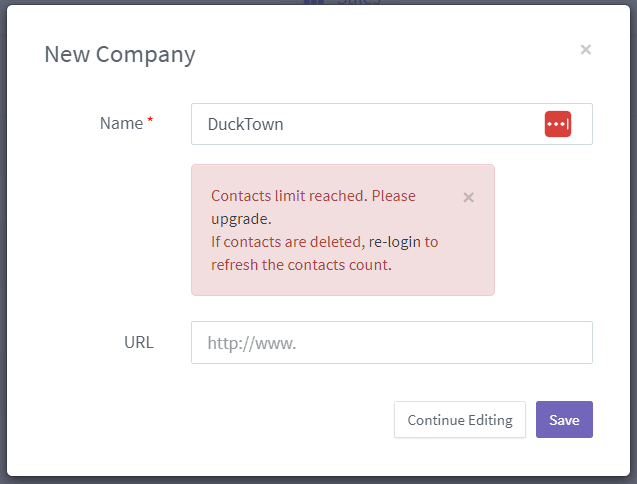
We’re now already edging closer to understanding who the free version will help. A 10-rep team selling a transactional offering won’t fit inside the 1000 record limit for very long. In fact, very few will.
If you have a new company and you want to land 100 new customers, you’ll want to work with a list of likely more than a 1000 companies. That would make the current limitation of 1000 contact or company records essentially nothing more than a free trial.
That’s fine as long as you know what you’re getting yourself into.
Both types of records can be equipped with and filtered by tags for stronger categorization. These filters are applied by use of “AND”. That’s OK, yet it also means you can’t create filters that show records that fit either with this statement OR with that statement.
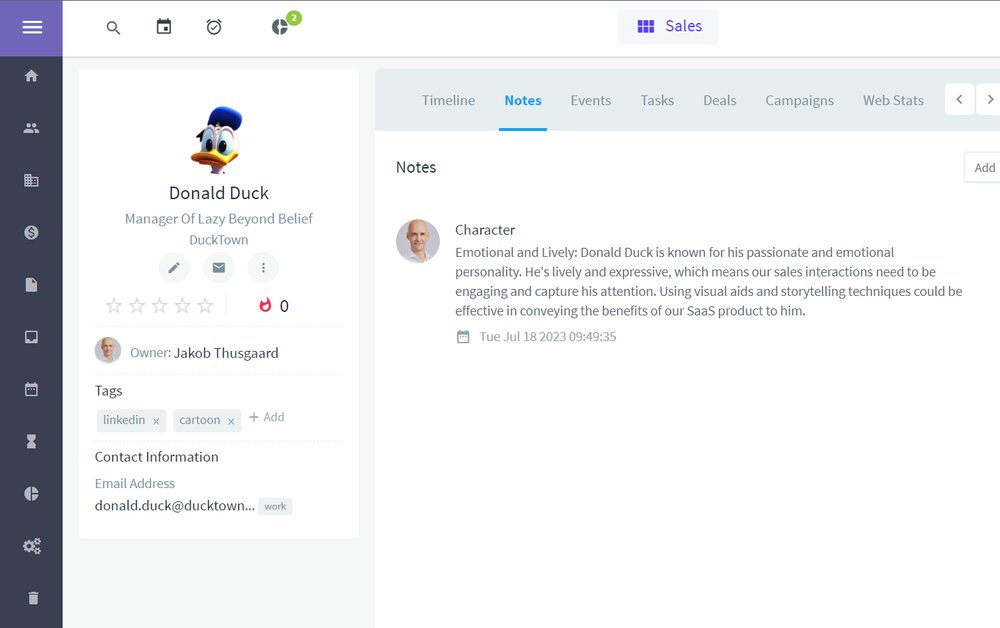
Agile CRM Free comes with a deduplication feature, so you can easily get rid of duplicate contacts or companies. In some CRM packages this is a paid feature. It’s valuable, because it allows you to lift the data quality in your CRM.
Agile CRM’s contact records require an email address for each contact. It’s what makes each contact unique. Oddly, it’s possible to import a list of contacts and import completely random data into the email address field. If you later attempt to edit any information on a contact with such data, though, you need to enter some sort of email address.
Finding a record – be it a company or a contact – is very easy with a search feature that looks across all kinds of records for the search phrase you pick.
Agile CRM gets a score of 4 out of 10 (unsatisfactory) for its ability to store and organize customer data.
Pros:
- ability to add tags.
- ability to add custom fields.
- deduplication in the free version.
Cons:
- The 1000 record limit is too low to be useful for most companies.
- As you approach that limit there are glitches in the record count.
Forecasting sales with Agile CRM
Since forecasting is essential to sales teams, any CRM – free or not – will have to provide tools to make forecasting as easy and as accurate as possible.
To recap, sales forecasting is required to:
- See if you’re delivering on expectations
- Enhance Revenue Predictability
- Improve Inventory and Supply Chain Management
- Create Effective Sales and Marketing Strategies
- Improve Cash Flow Management
- Improve Project Management and Delivery Times
The free version of Agile CRM makes it possible to place a deal win probability percentage on each individual deal. The percentage doesn’t update automatically as the deal progresses through the sales funnel.
In other words, if a deal changes to a new sales stage that MUST be accompanied by a deal win probability update, since all things equal, deals that are further have a higher win probability. This isn’t ideal, as the more manual actions sales have to undertake in their work with deals, the higher the risk of error.
What you really want, is to understand your own deal stages to the extent where you know that a deal at stage ABC has X% change of closing. As deals progress through the sales stages that percentage should update automatically.
Below you’ll see the sales forecasting detail level you get for in Agile CRM’s free version. It’s based on a single 1M deal with a 20% deal probability. You’ll see that you get both the total value of the funnel as well as a number weighed by deal probability:

Alternatively, one might be looking for a report with more options and showing more detail. The Reports section has these capabilities, but in the free version it’s limited to a 7-day window. This is too short for most useful forecasting, where either month or quarter forecasts would be the typical requirement.
Do note that companies with a recurring revenue business model will have challenges with Agile CRM. There’s no standard way to report on recurring revenue. Potentially you could do this using custom fields, but frankly you’re better off just selecting a CRM that has what you need.
Remember the 6 points sales forecasting listed above? Go ahead, check them out again, we’ll wait…
…Done? OK, so for a company with a recurring revenue business model, the top 5 of those 6 points can’t be achieved using Agile CRM. An increasing amount of companies are exploring recurring revenue models at the time of writing. All those companies will not be happy users of the free version of Agile CRM’s sales forecasting capabilities.
Agile CRM gets a score of 4 out of 10 (unsatisfactory) for its ability to forecast sales. It DOES give simple forecasting to non-recurring revenue companies. However, it’s error-prone in its way to update deal probability and wouldn’t work at all for companies with requirement for recurring revenue forecasting.
Pros:
- ability to create a simple forecast.
Cons:
- No obvious recurring revenue reporting options.
- Error-prone handling of deal probability.
Capturing client and prospect communication
Very little testing was required for this chapter. Agile CRM’s free version refused to connect with Google Workspace. It might work with IMAP and Office 365, but really it just needs to work as advertised for everyone.
Agile CRM gets a score of 1 out of 10 (Very Poor) for its (lack of) ability to capture client and prospect communication.
Pros:
- none.
Cons:
- We tested on Google Workspace. That didn’t work at all. We should not assume this will be any different in a Microsoft scenario.
Agile CRM Review: Building and growing existing accounts
As we’ve explained in the past, the building and growing of existing accounts is far easier and cheaper than winning new accounts. Therefore it’s essential for any business.
The free version of Agile CRM does tick some of the boxes required in the building and growing of current customers. There are problems, though. Let’s explore.
A key aspect is centralising all data. Clearly, in principle, Agile CRM takes care of this. As we’ve already shown, though, Agile CRM has problems with data limits. They’re both too low and too buggy to really be functional.
This means that while the data does indeed get centralised, there’s not enough of it. Especially not if you factor in that you’d probably want to both expand current accounts AND find new customers.
In addition, centralised captured customer communication didn’t actually work at all on Google Workspaces. This already caused Agile CRM to fail the capture comms. Obviously, it’s not possible to fail that test and pass it when it comes to expanding current accounts.
When it comes to other centralised data, there’s just not much to find in terms of standardised reporting. You may indeed be able to configure your own reports. The standard reporting doesn’t offer much, though, so that won’t help.
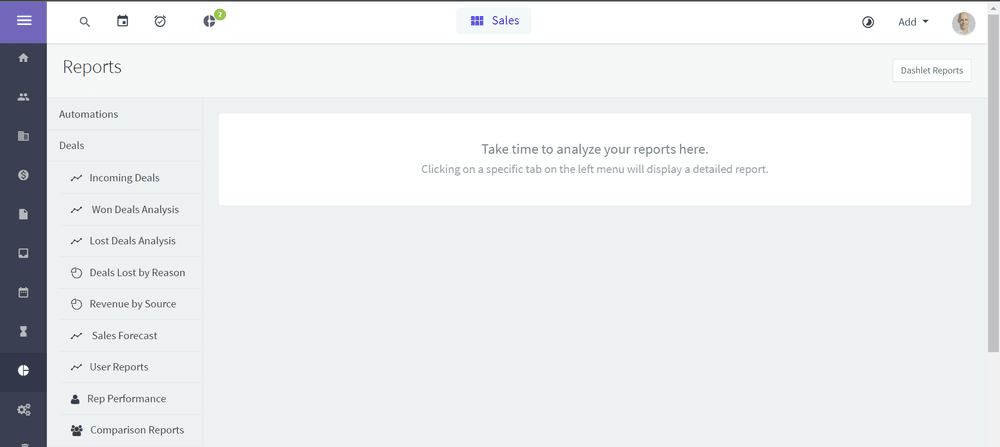
Also not in Agile CRM: a way to collaborate with other team members about accounts, contacts, or deals. You can’t include mention of one of your company team members. There’s also no deal chat or a messaging function as in some other CRMs. There’s just zero collaboration options. If your customer journeys involve more people – as they typically would – you’ll be forced to have the collaboration happen outside of your central source of truth for customer relationships. There’ll be not trace of that collaboration in Agile CRM.
Workflow Automation in Agile CRM
Agile CRM’s free version includes their own automations builder. Thumbs up for that! You can create a single automation – just enough to get a feel for the builder and not enough to really get anything serious going. Think carefully about how you apply that single credit.
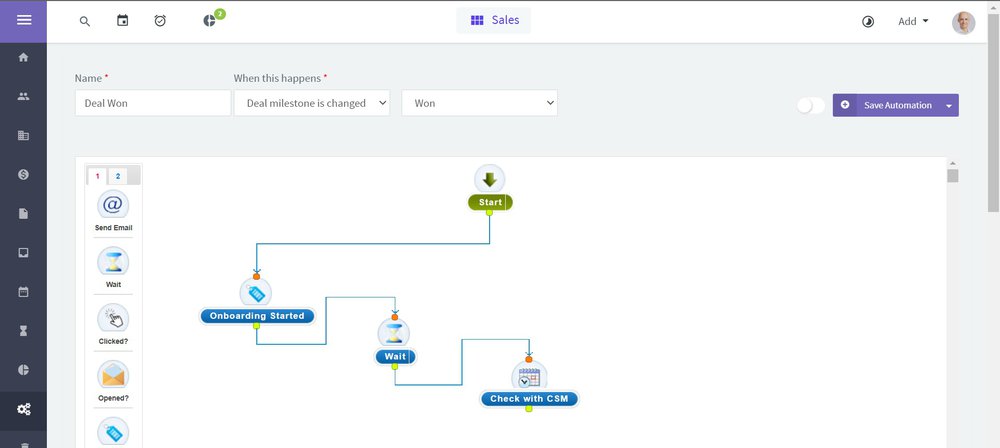
This helps – but as with contact credits, it’s just too little. You could attempt to design the entire customer journey in a single automation. That’s likely to become very complex and inaccurate as variations in customer journeys emerge. It’s way more flexible to create a number of automations for a number of scenarios. Alas, in Agile CRMs free version this won’t work.
What DOES work is to integrate Agile CRM with an external automation platform like Zapier. You could create automations (called Zaps), which take an event from Agile CRM and use it as a trigger to have an action happen in Agile CRM or indeed elsewhere.
There’s no specific mention of Zapier on the Agile CRM pricing page, yet it should reflect positively on Agile that they’ve chosen to include the Zapier integration also in the free version.
Data-Driven Insights and Reporting to build existing accounts
The reporting module doesn’t seem to have much in terms of finding insights on specific accounts. Other reports are available, but they won’t teach us much about the trajectory or preferences of customers. Not in general nor specifically. There are other things we can learn, but not this. Hence the reporting module doesn’t feel helpful when it comes to growing accounts.
Agile CRM gets a score of 3 out of 10 (Very unsatisfactory) for its (lack of) ability to help grow existing accounts. What keeps it from a lower score, is the presence of a single automation credit and the Zapier integration.
Pros:
- The Agile CRM Automations module IS included, even if it’s limited to just a single automation.
- Integration with Zapier is possible, increasing the score ever so slightly.
Cons:
- Just a single automation credit.
- Just a single integration credit.
- Although data is centralised in principle, there’s no way to include collaboration other than maybe by notes.
- Capturing customer communication is still broken.
- Too few contact contacts & companies credits to realistically make growing existing accounts work.
Provide Data & Insights to enable leaders and teams to know where they need to work
Creating guiding beacons in a sea of information. That’s what structuring data and creating insights is all about. Eliminating guesswork is the name of the game.
The insights we’re attempting to extract can be slotted into the following categories:
- Customer behaviour
- Market trends
- Team performance
- Individual performance
When it comes to customer behaviour, the free version of Agile CRM presents us with challenges. The 1000 contacts or companies we can enter into the system were already too little, as discussed here. If we were to analyze data on those contacts or companies, we would likely have 500 of each, assuming you have at least one contact per prospective customer. That means the sample volume would never exceed 500 and in most cases would be a lot smaller. The question is whether that would make the sample size large enough to make it representative of the market you’re trying to analyze. We question that.
In addition, if you’re using Agile CRM to send emails and are trying to learn what works best – learn which customer behaviour yields the best results, you might want to set up a marketing campaign. An A/B testing campaign lends itself well to that kind of analysis. Yet, the marketing campaign module in the free version of Agile CRM comes with a maximum of 5 nodes. That means you can you can send an email and test for an outcome. Want to make the campaign longer? Then you can’t test for anything because it takes you over the 5 nodes you have available.
This could be OK, actually, although fairly limiting.
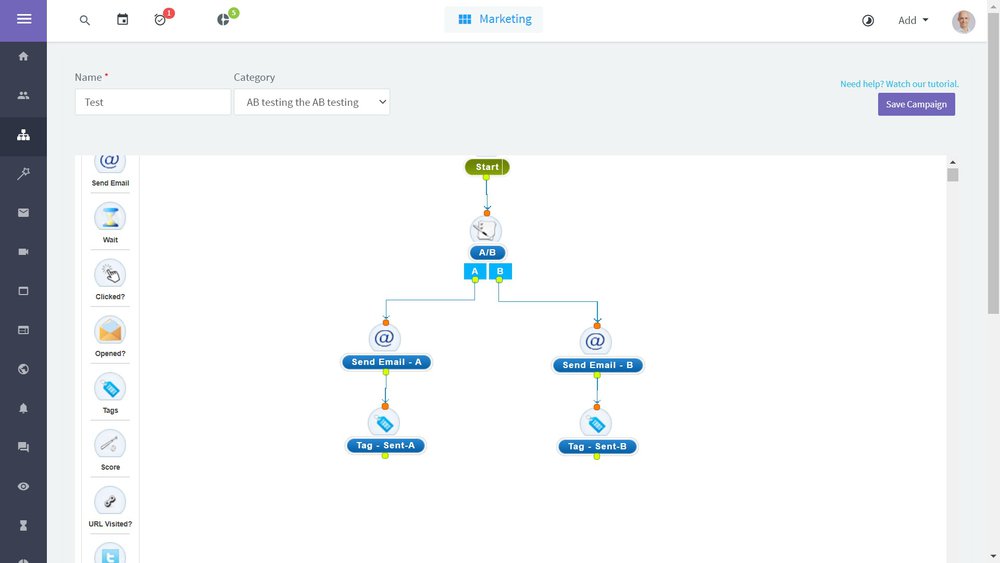
What’s not OK, is that you can just do a single campaign. Imagine you want to learn both what works for Sales Development Reps, Account Executives, newsletters, and Customer Success. You just very quickly run out of campaigns, and will need to find other ways to learn what works and what doesn’t.
Market trends learning really deals with the same limitations. The sample size is rather small. There are other marketing features in the free version of Agile CRM, and that falls outside the scope of this review, which deals solely with the problems sales leaders want solved.
When it comes to Team and Individual performance, “Basic Reports” are available in Agile CRM’s free version. Supposedly it should be possible to set up voice integration with both SIP and Twilio. Yet, integrations require at least the regular version of Agile CRM, and the Android and iOS apps were last updated in 2019 and 2017 (!) respectively. On Android this means it won’t install on newer devices. This means no call reporting is available = no learning about calls.
There is an applet you can install on the main dashboard. It’ll show you revenue won, quantity of deals won, call quantity, and tasks quantity for the periods this/last week, month, and quarter as well as a custom period setting.
Also here, the call reporting doesn’t work, so you’ll have to do with the other three metrics. They’re not uninteresting and you can do a simple level of management and – yourself – extract insights from the numbers. That’s not quite the same as reports presenting insights for you, though.
Agile CRM gets a score of 4 out of 10 (Unsatisfactory) for its ability to spoon feed leaders with data & insights.
Pros:
- Agile CRM’s free version can provide data on tasks, won total revenue, added funnel, and won quantity of deals. This does make simple management possible.
Cons:
- Sample sizes for statistical analysis likely too small.
- Use cases for some reporting is very niche and requires diligent or automatic use of the contact tag feature. Experience tells that manual use of such a feature will be sporadic at best.
- There’s limited data and little to no insights.
Cost-drivers – price required to sufficiently solve the 5 elements listed above
This is where we look at what happens IF you should start using the free version and then outgrow the free version and start feeling a requirement to upgrade. There are several scenarios that could cause an upgrade.
Agile CRM’s free version has room for up to 10 users. That means user number 11 will require you to be bumped up to any of the paid versions. If you’re happy with the feature set in the free version, just moving to the $9 per user per month plan will be sufficient. That lands you at a minimum of $99/month.
Realistically you’ll reach that point way sooner, though. 500 contacts + 500 companies is just not a lot if you both do acquisition of new customers and growth of existing customers.
Adding more than a single automation or creating further integration with Zapier, driving cost up for the overall sales stack, except if the free version of Zapier will do. If you just want to automate within Agile CRM, the Starter version with its 5 automations will quickly be too little as well, which lands you on the “Regular” plan at $29.99 per user per month.
If you don’t land here because of the need for automation, you’re likely to land here because the standard deal track with the deal stages new – prospect – proposal – won/lost is likely not going to work for you. After all, you’ll want to create a playbook, telling sales professionals when to put a deal in which stage. The standard deal track leaves little room to maneuver. An upgrade to the “regular” plan seems inevitable.
You may as well calculate $29.99 x number of users per month. At least if it wasn’t for the fact that :
Agile CRM Looks Like a Dead Product
All the troubles aside there are plenty of reason to avoid Agile CRM – free or not. Simply put the product looks dead and abandoned:
- the iOS version was last updated in 2017.
- the Android version was last updated in 2019.
- the “upcoming” webinars are “going to happen” in 2021.
- …and the calendar you can use to schedule time to talk with “your” sales rep has zero availability – forever.
- We reached out to Agile CRM for comment and received no response.
Conclusion
On the surface Agile CRM’s free version manages to look interesting. It has a bunch of bells and whistles and combines sales tools with marketing and service tools. Yet if the sales tools in the package don’t solve the problems sales leaders expect software to help solve, then what’s the point?
Agile CRM’s free version ends up with an average score of 3.2 (very unsatisfactory). Given all the quirks, that even feels like they had a pass. Here and there they just manage to push in a few features that are mildly interesting. They don’t manage to save the day for Agile CRM, though.
From here our strongest possible recommendation to not use Agile CRM. Use something else. Good luck – and happy selling !

